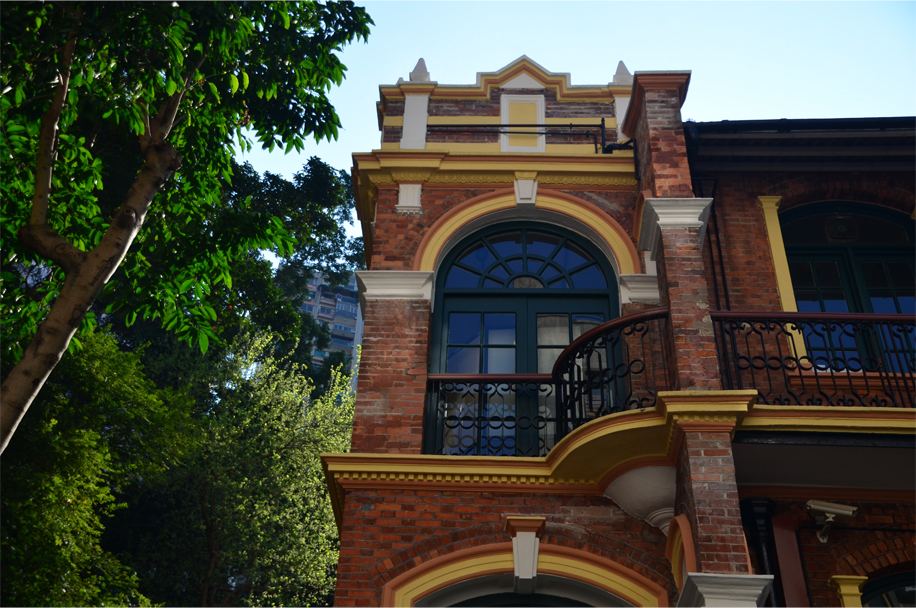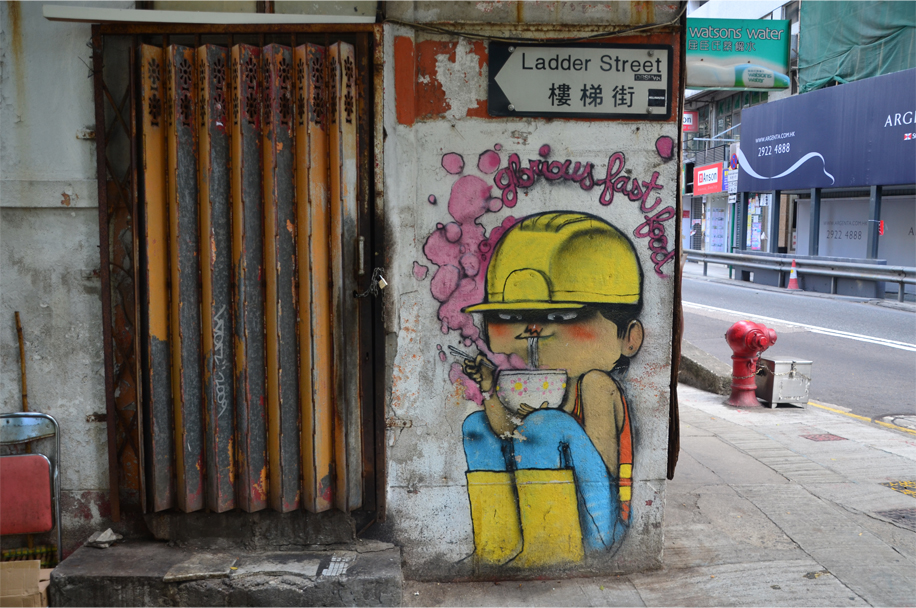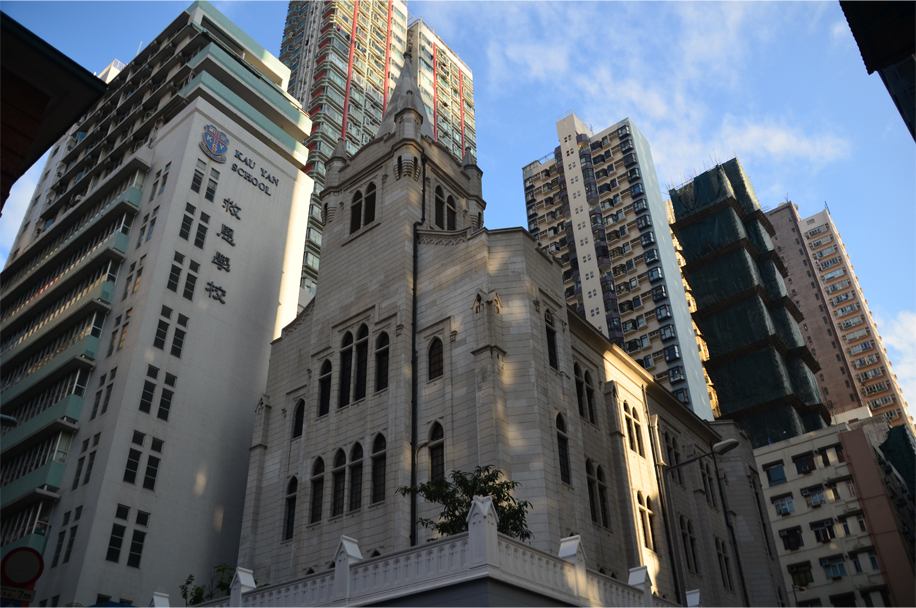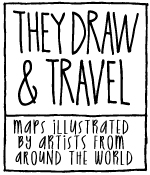Borrowed place, borrowed time
Walking down the length of Wing Lee Street, I couldn’t help but marvel at the degree of change around me. The ageing tenements running along one side had been renovated in bright pastel yellow, with balconies and windows refitted to accommodate new tenants. A cheery sign midway indicated the presence of an artists’ studio. Formerly earmarked for demolition, the entire row was saved after a public outcry following its appearance in Echoes of the Rainbow, winner of a Crystal Bear at the 2010 Berlin Film Festival.
In the simplicity of these low-rise tenements I glimpsed the city of my parents, when the harbour was much wider and the tallest building was the 26-storey Mandarin Oriental. My mother spoke of days when the cool ocean breezes drifted in through the window, and my father remembered the sound of seagulls, now conspicuously absent from the waterfront.
At the time Hong Kong was a colonial outpost perched on the edge of a fervently Red China, a sickly giant gripped in turmoil and closed to the outside world. Wave after wave of refugees flooded in, many seeing the city as a point of transit to a better future elsewhere. The government struggled to provide housing to counter the growing shantytowns that mushroomed on slopes across the territory. My parents talked of water shortages when the taps would only be turned on twice a week, several hours at a time. Those who chose to remain would attempt to make their fortunes on limited resources, propelling the colony to the cusp of an unprecedented boom.
In a 1959 article penned for Life magazine, titled ‘Hong Kong’s Ten-Year Miracle’, novelist Han Suyin described a city that was witnessing the waning decades of the British Empire.
Squeezed between giant antagonists crunching huge bones of contention, Hong Kong has achieved within its own narrow territories a co-existence which is baffling, infuriating, incomprehensible, and works splendidly – on borrowed time in a borrowed place.
Han Suyin herself was an extraordinary individual who bridged the gap between East and West. The daughter of a Chinese father and a Belgian mother, she grew up in China during an age when being Eurasian was not seen as an asset, but an affront to the views of racial purity that were dominant at the time. After studying medicine in Brussels and London, and losing her first husband in the Chinese Civil War, she returned to Hong Kong as a practicing physician.
It was her semi-autobiographical work, ‘A Many-Splendoured Thing’ (1952), which catapulted her to international fame. Three years later the bestselling novel was turned into a Hollywood blockbuster starring Jennifer Jones and William Holden. The hillside pavilion where Han met with her lover, Australian war correspondent Ian Morrison, still stands to this day.
Although Han considered the city’s metamorphosis unique for its time, she had not yet seen the miracle that was still to come. Over the next thirty years, Hong Kong would emerge as a global manufacturing centre before reinventing itself as a major financial hub. Alongside Singapore, Taiwan and South Korea, the territory would take its place as one of the Four Asian Tigers.
Half a century has brought many episodes of rapid change, but the Hong Kong of today is still a ‘baffling co-existence’ that Han would easily recognise. Bamboo scaffolding sheathes half-finished giants in steel and concrete, and the need for technology is tempered by a strong belief in feng shui practices and age-old superstitions.
Starting from Wing Lee Street, I spend an afternoon exploring Sheung Wan, the ‘upper ring’ beside the financial district, and Sai Ying Pun, the ‘western encampment’ whose steep streets were laid out on a simple, idealistic grid. The signs of development are everywhere: I pass the construction site of a new metro station, and the beginnings of monsters veiled in green canvas – the next big luxury apartment block with a ludicrous name and sweeping sea views. As far west as Sai Ying Pun, traditional neighbourhood stores have given way to artisanal cafés and organic shops, a spillover from the expat haven of SoHo.
Decades of continued prosperity have left their mark on the skyline, but beyond the corporate towers of Central, the older neighbourhoods remain dotted with potent reminders of an earlier age: green-painted hawker stalls, family-run businesses, red brick buildings and creeping banyans. Together, they whisper anecdotes from the borrowed time of Han Suyin.
Leave a reply to Jean Cancel reply
This site uses Akismet to reduce spam. Learn how your comment data is processed.

























What a lovely trip through a part of Hong Kong I have not seen.
Perhaps it’s something to look forward to the next time you visit on the way back to Brisbane. 🙂
Hey James, I love this post!
I love the pictures because that’s one of the sides of Hong Kong I liked so much when I went there, when it reminded me of England after spending 5 months in China…
Also, I watched the film you mentioned last year maybe and it was strange and lovely to see Hong Kong being filmed in the 50s, and remember the main actress’s many dramatic thoughts on her Chinese origins…I didn’t realise it was a real story!
I’m glad you do, Sophie. 🙂
Hong Kong does seem to navigate a happy medium – on the whole I’d say the city is deeply Chinese but simultaneously open to the West. And I do love spotting the occasional Edwardian building as well, there are signs of the British presence in many of the older neighbourhoods.
Sadly I haven’t watched Echoes of the Rainbow just yet… I was living in Spain when the movie came out, judging from the trailer it does seem like quite the tearjerker!
Hey James! Oh actually I meant I saw the “Love is a many-splendoured thing” film but I just watched the trailer for Echoes of the Rainbow and it does seem very touching.
I love the fact that some buildings were saved as they appeared in that film! 🙂
I always love the story of how a place evolved through different periods of time in history. It’s fascinating to imagine how HK would look like decades ago before the Asian financial and economic boom which brought prosperity to many parts of the continent. This post makes me want to write a story on Jakarta’s history, apart from Kota Tua of course.
I love the color of the Old Pathological Institute. However it looks like it has just been repainted because the colors look very vivid for an old building.
I could have gone into much greater depth about HK history, but I didn’t want the text to stray too far from the photos. 🙂
As for the Old Pathological Institute, it’s easily one of my favourite colonial buildings in the city. I remember it being under scaffolding when you visited last January so that would explain the fresh new look. The red bricks have aged very well though!
Such beautiful photos of an amazing city. I love Hong Kong and was nice to read the personal side of it’s history, thank you!
You’re welcome Amanda! I just had a look at your blog and I’m thrilled to discover you’re based out of Saigon. Loved the city when I visited just last month – I have a feeling Vietnam will be calling me back in the near future.
James, are your parents originally from other parts of China?
When you wrote “The government struggled to provide housing to counter the growing shantytowns that mushroomed on slopes across the territory” I remember Manila – and how we could learn a lot from HongKong in managing urban migration.
Not quite – my parents were born and raised in Hong Kong, but my grandparents on both sides came from elsewhere. Both my paternal and maternal grandfathers trace their ancestry to Toisan, a Cantonese region west of Macau, while one grandmother is Shanghainese and the other also Cantonese (but from a different region). Further back it gets more complex as a great-grandmother was from Shandong in the north. It’s a fairly common story because the vast majority of Hong Kongers are descendants of recent migrants from other places.
That’s an interesting comparison, although the challenges faced by Manila seem far greater judging by the numbers alone!
Reblogged this on lizziedun.
Wonderful post James. And beautiful photos. Your parent’s must have countless fascinating stories of their early years in Hong Kong! While we enjoyed the colonial architecture and the glitzy highrises, we opted to stay in the Sheung Wan area on our second visit and loved it! Part of the attraction was being able to travel by tram 🙂
Thanks Madhu. 🙂 I grew up hearing many accounts of the way things were in a simpler time. My mother would occasionally tell us that Hong Kong used to be much nicer: friendlier, cheaper, less crowded and an education would get you much farther than now!
Sheung Wan is a great neighbourhood, so traditional but right next door to cosmopolitan Central. I’d even say it has its own particular smell – a mixture of dried seafood, herbal medicine and diesel fumes!
If only time travel was a possibilty! 🙂
Another great walk with the James and family memories scrapbook close to hand. One day i’ll go back and really look around instead of gritting my teeth because I have to stop over … 🙂
Between you and Madhu we have an inspiring collection of anecdotes from the past – the next time I visit the grandparents perhaps I’ll scan some photos of old Hong Kong for a “before and after” post. 🙂
You keep making me want to go back to actually see HK!
I also low how slightly out of focus, and thus, soft that picture of a cat is. While we’re talking about cats, of course street art in Asia adorable.
Well, I could say the same thing about all your posts on Japan! 😉
It was a happy accident – the cat kept moving so none of the pictures turned out really clear. What made it even better was the fact that there were three cats, all at different distances from the camera.
haha thanks. If I remember correctly, you should be getting ready to go back soon? maybe?
Those are always good moments. Along with the other cats that are evenly spaced out behind it. They knew and were posing, like the egotistical creatures that they are 😉
Reblogged this on " F I N I T U D E ".
I read several Han Suyin’s book. She wrote eloquently of the terrible time in Communist China history 1970’s, etc. She gave us much insight. Thank you for these neighbourhood haunts. A totally different side of HK.
You’re welcome Jean. 🙂 Han Suyin was an extraordinary author far ahead of her time; I think she was a trailblazer for the Eurasian community, literary and otherwise.
Wow, love the architecture in Hong Kong. Nicely framed!